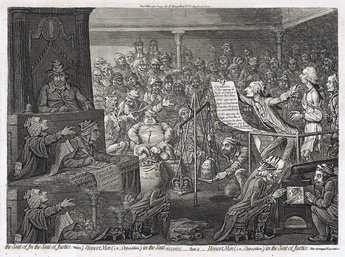Patriotic regeneration, - viz. - Parliament reform'd, a la françois, - that is - honest men (ie - Opposition) in the seat of justice
Only £235.00
Size 44cm x 32cm
Originally published by Hannah Humphrey etched by James Gillray from 'The Genuine Works of James Gillray, engraved by himself. Thomas McLean edition on heavy rag-paper from the original copper plates printed 1830.
Gillray is justifiably celebrated for portraying the depravity to which the French Revolution could lead in prints like Un Petit Souper a la Parisienne. . . (1792), Sans-Culottes Feeding Europe with the Bread of Liberty (1793), and, most obviously, The Blood of the Murdered Crying for Vengeance (1793).
But from early on, Gillray understood that the best way to help his countrymen understand what was happening in France was by imagining and portraying what it would look like if it were happening at home. That began as early as A View in Perspective. The Zenith of French Glory. The Pinnacle of Liberty (1793) which portrays the execution of Louis XVI and the hanging of judges and priests, but substitutes the unmistakable dome of St. Paul's Cathedral in London burning in the background for the actual Eglise Notre-Dame-de l'Assomption nearby the site where Louis was beheaded. And it continues inPatriotic Regeneration. . . in much more concentrated form. Here Gillray has, in effect, translated the sham trials of the National Convention during Robespierre's Reign of Terror into an English equivalent in the House of Commons, now named (according to the scroll before the Speaker's Table) "The British Convention."
In this exquisitely imagined post-revolutionary scene, the Francophile Whigs wearing their bonnets rouges have taken complete control of the House of Commons. As in France, the crowns and jewels of the Royal Family have been seized, the estates of "Loyalists" like the Chatham and Grenville families, have been forfeited. Cash from the Treasury has been converted to the famously worthless French Assignats. And now, most importantly, former Prime Minister William Pitt has been manacled and placed in the prisoner's dock. Earl Stanhope, caricatured by Gillray in May 1794 as The Noble Sans-Culotte, points accusingly at Pitt as he reads from an extensive list of ironically itemized "Charges," for which Pitt is being tried, including:
Ist For opposing the Right of Subjects to dethrone their King.
2d For opposing the Right of Sans-Culottes to Equalize Property, & to annihilate Nobility.
3d For opposing the Right of Free Men to extirpate the farce of Religion, & to divide the Estates of the Church.
Pitt is dressed only in a torn white shirt which may be intended to recall another sham trial—Jesus before Pontius Pilate. Behind Pitt is Lord Lauderdale, an outspoken critic of Pitt's policies in the House of Lords, carrying an executioner's axe and holding a noose around Pitt's neck. Sitting opposite Pitt in the Speaker's chair and acting as presiding judge over this trial, is the Whig leader Charles James Fox. Beneath him, the famous barrister, Thomas Erskine, identified by papers in his pocket alluding to his recent successful defence of the radical Thomas Hardy, but now in the role of prosecuting counsel, seems to be arguing for the death sentence. On the paper he holds in his hand is the word "Guillotine." Next to him the financially scheming and habitually indebted Richard Brinsley Sheridan seems to be making notes of valuables he could acquire.
The "jury" packing the benches at this trial all wear bonnets rouges and come from the various trades, including chimney sweeper, hairdresser, butcher, and tailor, with a couple of dissenting ministers thrown in for good measure. It is likely no accident that while talking to the hairdresser, the tailor is shown with open shears gesturing towards Pitt as if he would cut off something more substantial than a few hairs of his head. And it is clearly noteworthy that the most conspicuous tradesman is a butcher.
As if the unfairness of this trial were ever in doubt, in the centre we can see the scales of justice being forcibly manipulated by the always shifty Marquess of Lansdowne so that a French bonnet rouge will assume more weight than the British crown. To the right of Lansdowne, and beneath the gesticulating Citizen Stanhope, a group of other Whig aristocrats, including Earl Derby and the Dukes of Grafton and Norfolk warm themselves by burning the foundational documents of British liberty and religion, the Magna Carta and Bible. And as a conspicuous announcement of the annihilation of the nobility to which they belong, Grafton and Norfolk use their ducal coronets as tuffets. Gillray's extensive use of aquatint casts an appropriate pall of semi-darkness over the whole proceeding. (www.james-gillray.org)
 View Account
View Account
